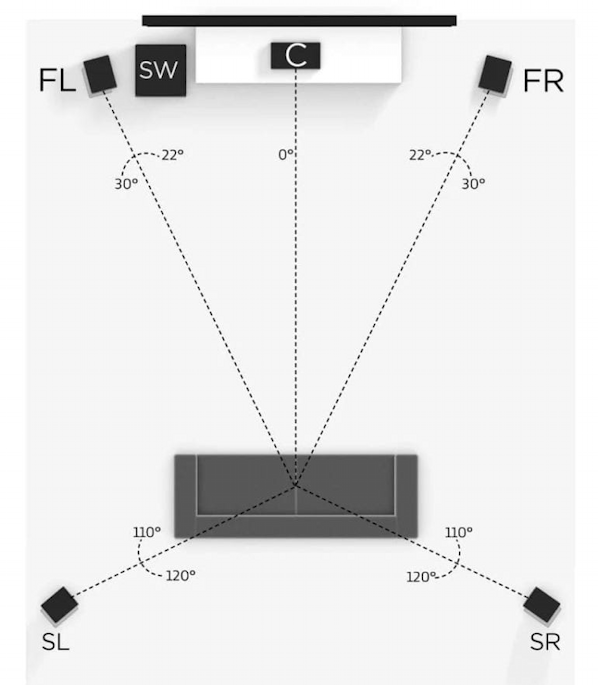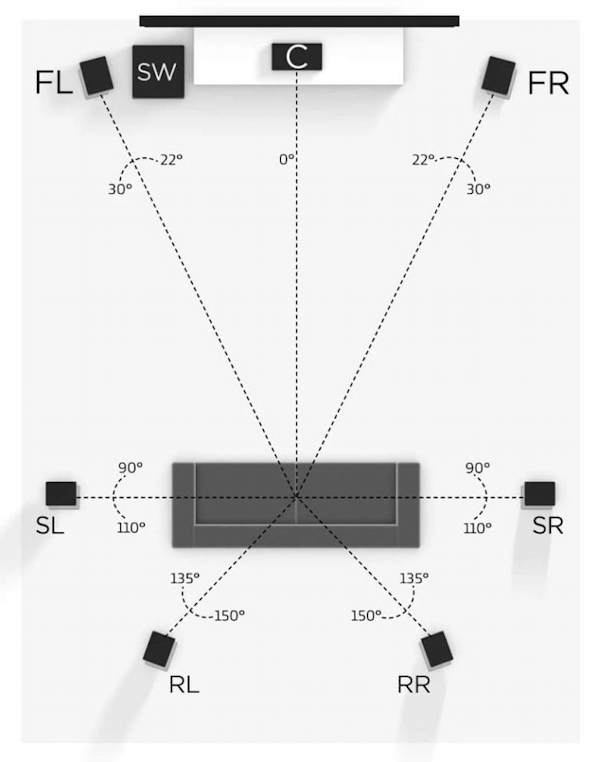Under Construction 
Things in brackets [] are my personal comments.
See Glossary of Terms in tech/Sound
Home Theater/Surround Sound:
Surround Sound or Home Theater is a technique for enriching the fidelity and depth of sound reproduction by using multiple audio channels from speakers that surround the listener (surround channels). Its first application was in movie theaters.
Surround sound first showed up with Walt Disney's "Fantasia" in 1941. To show the movie with surround sound, a movie theater had to spend $85,000 for a special setup that included custom loudspeakers and required two projectors, one running the film and one track of audio.
The first time surround sound became available in the home in 1969. It was called Quadraphonic sound, and it first appeared on reel-to-reel tape.
Stereo, which became widely available in 1958, is fine for music in general.
What it's good for and when is it a waste of money.
Surround Sound was hyped for more theater like sound. But the only advantage I can see is in action and animated movies with things like helicopters flying over your head.
Music is usually performed in a venu with sound coming from in front of you or a studio with individual instruments and voice recored on separate channels which are mixed to produced to a 2 channel master, so surround sound doesn't add anything. See below.
Maybe you could simulate a concert hall environment with microphones behind the audience to capture reflected sound, but I couldn't find any articles which said this was done. Anyway concert halls are designed to minimize reflect sound.
What surround sound is best for is gaming.
However, in 2021 Apple and others are claiming improved sound with Dolby Atmos for things like spacial audio, lossless audio.
Dolby claims you can "Go beyond conventional, two-channel audio limitations with more clarity, space, and depth."
See Dolby Atmos below.
[My personal take on this is that the whole thing is designed to sell more speakers, upgraded receivers and TVs and music sources e.g. Amazon Music]
[I listen to mainly music either streaming or live concerts on TV
and don't generally watch action movies and I am not a gamer,
so a home theater setup is a waste of money on new speakers and an upgraded receiver.]
You should listen to Music in stereo
For playing from a stereo music source to a home theater system
the two audio signals composed in the stereo will be “copied” and “pasted” onto additional left and right speakers.
Some people may like this effect but it not authentic.
[I listened to some sample ATMOS demos with headphones and they sounded good but were not the original. So if you're a purist and want to stick to what the artists originally produced you should stick to stereo. However electronic enhancement has it's appeal.]
You should listen to Music in stereo | HomeTheaterAcademy 2022.
The Ultimate Sound Guide: Every format explained | Digital Trends, 2021
Digital music is also getting the Atmos treatment, with a number of streaming services (Tidal, Amazon Music, and Apple Music, to name a few) already taking advantage of Dolby Atmos Music, an offshoot of its theatrical, object-based sound technology.
Competitors like DTS:X and Sony’s 360 Reality Audio will look to challenge Dolby for sonic supremacy in the months and years ahead.
Generally, the needed range for Rock music is about 60 Hz to 8,000 Hz, with Classical extending at both ends from 40 to 12,000 Hz
However, for accurate depiction of an acoustic environment, such as a halls, side reflections are essential.
Surround sound (multichannel techniques) can be used in a live performance or in the context of an open-air concert, of a musical theatre performance or for broadcasting;
In 1967, the rock group Pink Floyd performed the first-ever surround sound concert at "Games for May", a lavish affair at London’s Queen Elizabeth Hall where the band debuted its custom-made quadraphonic speaker system.
The angles between the speakers have been standardized by the ITU (International Telecommunication Union) recommendation 775 and AES (Audio Engineering Society) 2004.
A subwoofer channel (Low Frequency Effects (LFE) channel) is used for base frequencies.
Video games also use multichannel techniques.
<>>P>
In movies sound can originate behind you. e.g. a car coming from behind you and moving to in front, so you need rear speakers for a more realistic effect.
See Surround sound - Wikipedia
There are 2 ways of getting this. One with a specially encoded source distinguishing beteewn the left, right front and back or a system that analyzes the stereo sound to determine what is coming from the front and back.
Encoded source:
One way to access surround sound is to use an encoding/decoding process. This process requires the surround sound signal to be mixed, encoded, and placed on a disc, streamable audio file, or another type of transmission by the content provider (such as a movie studio).
An encoded surround sound signal must be read by a compatible playback device (Ultra HD Blu-ray, Blu-ray, or DVD) or a media streamer (Roku Box, Amazon Fire, or Chromecast).
Some encoding systems are:
Dolby Digital (DD, 5.1 or AC3), EX, Dolby Digital Plus (7.1), Dolby TrueHD, Dolby Atmos, DTS Digital Surround, DTS 92/24, DTS-ES, DTS-HD Master Audio, DTS:X, and Auro 3D Audio.
Higher-end Dolby audio formats: Dolby TrueHD and Dolby Atmos
TIDAL’s Dolby Atmos Music streams use Dolby Digital Plus encoding. Atmos audio in Dolby Digital Plus is typically encoded at bitrates between 384 and 768 kilobits per second. CD-quality is 1,411 kbps. Spotify’s “high quality” stream is 320 kbps
Surround sound processing Can convert a standard stereo input to 5.1 or 7.1
You need a home theater, AV processor, or a soundbar to do this,
The home theater receiver reading the incoming audio signal (which can be analog or digital) and then looking for embedded cues that indicate where those sounds might be placed if it were in an encoded surround sound format.
Some systems that do this are:
Dolby Pro-Logic: Up to four channels.
Pro-Logic II: Up to five channels.
Pro-Logic IIx: Can upmix two-channel audio up to seven channels or upmix 5.1 channel encoded signals up to 7.1 channels.
neo-cinematic and neo-musical; DTS Neo:6 (6.1), DTS Neo:X (6.1)
Although the results are not as accurate as surround sound that uses an encoding/decoding system, it provides an acceptable surround sound experience for most content.
Most surround sound processing formats can take any two-channel stereo signal and upmix it to four, five, seven, or more channels.
DVD, Blu-ray Disc, Ultra HD Blu-ray Disc, and, in some cases, cable TV and streaming content can transmit encoded Home Theater content using a technique called bitstream.
A subwoofer can be placed anywhere. In a corner will enhance to sound which may be good or bad. You need to experiment.
See:
What Surround Sound Is and How to Get It
Difference between Surround Sound and Stereo Sound – Arkartech
Dolby Digital, Dolby Digital EX, and Dolby Digital Plus | lifewire
The problem with hi-res audio is how you might be listening to it | WhatHiFi
5.1 Channel

A 5.1 surround sound setup has two front speakers, a subwoofer, a center channel, and two surround speakers. With a 5.1 setup, you should place the surround speakers behind the listener at a 110-120-degree angle per ITU ((International Telecommunication Union) recommendation 775 and AES (Audio Engineering Society) 2004.
Source: What Is the Best Way to Set Up a Surround Sound System? - The Plug - HelloTech
5.2 has two sub-woofers.
6.1 adds a center back channel.
7.1 Channel

See:
All About Home Theater
Home theater receiver setup guide
Digital Sound
Not only can optical and coaxial digital audio connections carry multichannel audio for surround sound, they can also provide crisper, more detailed stereo sound than an analog connection. These are especially good options when connecting video components that don't support HDMI but do offer digital surround sound.
Optical Digital to Analogue Converters (DAC).
As Far as I know the only receivers that are going to have optical audio inputs are AVRs. Standard stereo receivers don't need them, because if you're doing 2 channel analog audio there is no advantage to having a digital input.
Dolby ATMOS
Atmos was the hot technology in 2021,2022.
A surround sound technology intorduced itn 2012 that expands on existing surround sound systems by adding height channels, (up to 128 total channels) allowing sounds to be interpreted as three-dimensional objects.
It's created with special mixers that allow different elements (instruments) of the sound to eminate in 3 demensions, front, back, side, above.
These elements can move around.
Most electronic devices since 2016, as well as smartphones after 2017, have been enabled for Dolby Atmos recording and mixing.
In june of 2021 Apple announced that Apple Music is bringing industry-leading sound quality to subscribers with the addition of Spatial Audio with support for Dolby Atmos.
'Object-based audio' is the foundation of Dolby Atmos. Each sound in a scene has information explaining where it should be placed in the speaker configuration, and Dolby claims to have married these two technologies together to create a virtual, enveloping surround-sound experience on a mobile platform.
For Dolby Atmos, the nomenclature differs slightly: a 7.1.4 Dolby Atmos system is a conventional 7.1 layout with four overhead or Dolby Atmos enabled speakers.
Playback devices:
5.1 or 7.1 home theater systems, TVs, receivers and headphones.
Some TV soundbars claim to support ATMOS.
Headphones: "They work by using audio processing algorithms to convert the Atmos object metadata into a binaural 360° output using the usual two headphone speakers."
[Whatever that means]
Streaming devices/services like Apple TV, Amazon fire.
Most smart phones produced after 2018, Samsung Galaxy S21,D20, S10+, iPhone 11.., ... support Atmos processing.
Apple Musics new Spatial Audio with Dolby Atmos feature will work with any headphones.
[I don't know what either of these mean].
Sources:
Dolby Atmos Music Creation 101: Getting Started Dolby - YouTube
Dolby Atmos - Wikipedia
ATMOS | Dolby
Dolby Atmos: what is it? How can you get it? | What Hi-Fi?
What is Dolby atmos | Digital Trends | YouTube
Links:
tech/frequency-response-specs.html
Speaker Frequency Response Specs
Stereo Recievers
Center Channel Speakers
Subwoofers
Bluetooth Speakers
Return to Audio-Video
|
 Home - Garden
Home - Garden
 Audio-Video
Audio-Video
 Audio - stereo - Home Theater (Surround Sound)
Audio - stereo - Home Theater (Surround Sound)
 Home - Garden
Home - Garden
 Audio-Video
Audio-Video
 Audio - stereo - Home Theater (Surround Sound)
Audio - stereo - Home Theater (Surround Sound)
